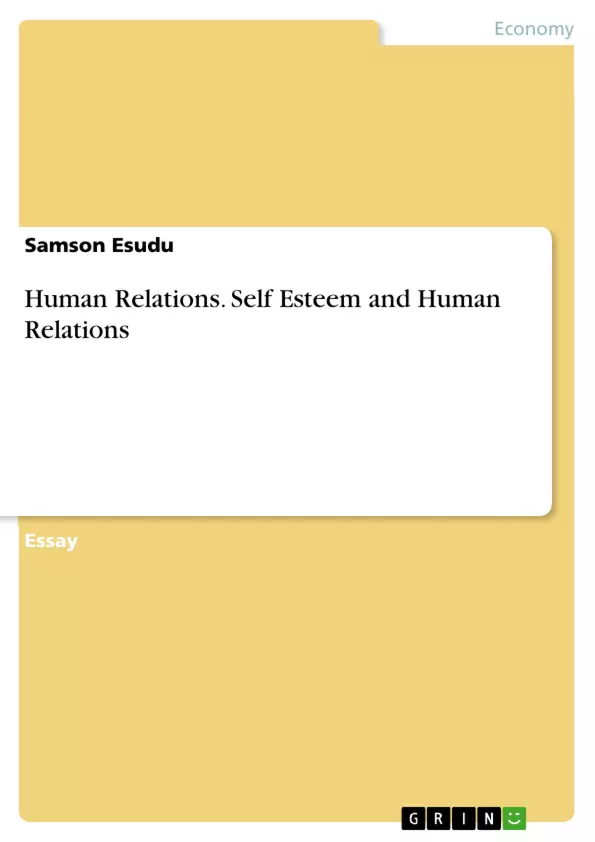This essay seeks to explain the meaning of the term Human Relations, how personal life influences each other, self-esteem behaviour and challenges faced in human relations. Relationships have many forces that influence the behaviour of other people at all levels. Human relations involve mainly communication, self-awareness, acceptance, motivation, trust, disclosure, and conflict management. These are the pillars in human relations with personal growth and satisfaction. I will therefore make strategic suggestions for solutions to challenges faced in human relations and conclusion that can lead to an improvement. The inclusive good relationship environment motivates and influences good human relationship and team work where peace and flexibility persists. My guiding contributions towards understanding on human relations will elaborate on challenges and resolutions for good human relations.
Table of Contents
- Introduction
- Human Relations
- Types of Human Relations
- Personality
- Self-Esteem
- Challenges faced in effective Human Relations
- Solutions to Human Relations Challenges
- Conclusion
Objectives and Key Themes
This essay aims to explain the concept of human relations, the impact of personal life on interpersonal dynamics, the role of self-esteem, and the challenges encountered in fostering effective human relationships. It explores strategies for improving relationships and offers solutions to overcome common obstacles.
- The definition and scope of human relations
- The influence of personal life and self-esteem on relationships
- Common challenges in effective human relations
- Strategies for improving interpersonal relationships
- The importance of communication, self-awareness, and conflict management
Chapter Summaries
Introduction: This introductory chapter sets the stage for the essay by defining the scope of human relations and outlining the key areas to be explored. It highlights the significance of communication, self-awareness, and conflict management in building and maintaining healthy relationships, emphasizing the essay's goal to provide insights into challenges and solutions within human interactions.
Human Relations: This chapter delves into the study of group behavior and its impact on interpersonal relationships. It emphasizes the interplay between personal life and professional interactions, illustrating how individual behaviors and communication styles influence relationships in various settings. The chapter further introduces methods for self-understanding, including gathering feedback from others and engaging in self-examination to improve interpersonal dynamics.
Types of Human Relations: This chapter explores the multifaceted nature of human relations across different levels and contexts, such as peer relationships, subordinate-supervisor dynamics, and employer-employee interactions. It examines the influence of formal and informal group norms on behavior and relationships within organizations, highlighting the complex interplay between individual actions and organizational structures in shaping successful interactions. The examples provided illustrate how different relationships influence and are influenced by organizational policies and expectations.
Keywords
Human relations, interpersonal relationships, self-esteem, communication, conflict management, group dynamics, self-awareness, personal growth, organizational behavior, teamwork.
Frequently Asked Questions: Comprehensive Language Preview on Human Relations
What is the overall topic of this document?
This document is a comprehensive preview of a text focused on human relations. It provides a table of contents, objectives and key themes, chapter summaries, and keywords to give a thorough overview of the material's content.
What topics are covered in the Table of Contents?
The table of contents includes: Introduction, Human Relations, Types of Human Relations, Personality, Self-Esteem, Challenges faced in effective Human Relations, Solutions to Human Relations Challenges, and Conclusion.
What are the main objectives and key themes of the text?
The text aims to explain the concept of human relations, the impact of personal life on interpersonal dynamics, the role of self-esteem, and the challenges encountered in fostering effective human relationships. It explores strategies for improving relationships and offers solutions to overcome common obstacles. Key themes include the definition and scope of human relations, the influence of personal life and self-esteem, common challenges, strategies for improvement, and the importance of communication, self-awareness, and conflict management.
What is covered in the chapter summaries?
The summaries briefly describe each chapter's content. The introduction sets the stage, defining human relations and highlighting key areas. The "Human Relations" chapter delves into group behavior and its impact on relationships, emphasizing the interplay between personal and professional interactions and methods for self-understanding. The "Types of Human Relations" chapter explores the multifaceted nature of human relations across different contexts, examining the influence of group norms and organizational structures.
What are the keywords associated with this text?
The keywords are: Human relations, interpersonal relationships, self-esteem, communication, conflict management, group dynamics, self-awareness, personal growth, organizational behavior, and teamwork.
What type of audience is this preview intended for?
The preview's structure and detailed information suggest it's intended for academic use, likely for students or researchers analyzing themes in human relations.
Where can I find more information about this topic?
This preview only provides an overview. To learn more, you'd need to access the complete text itself. The information here is meant to be a structured and professional analysis of themes within the complete work.
- Citar trabajo
- Samson Esudu (Autor), 2015, Human Relations. Self Esteem and Human Relations, Múnich, GRIN Verlag, https://www.grin.com/document/334341



